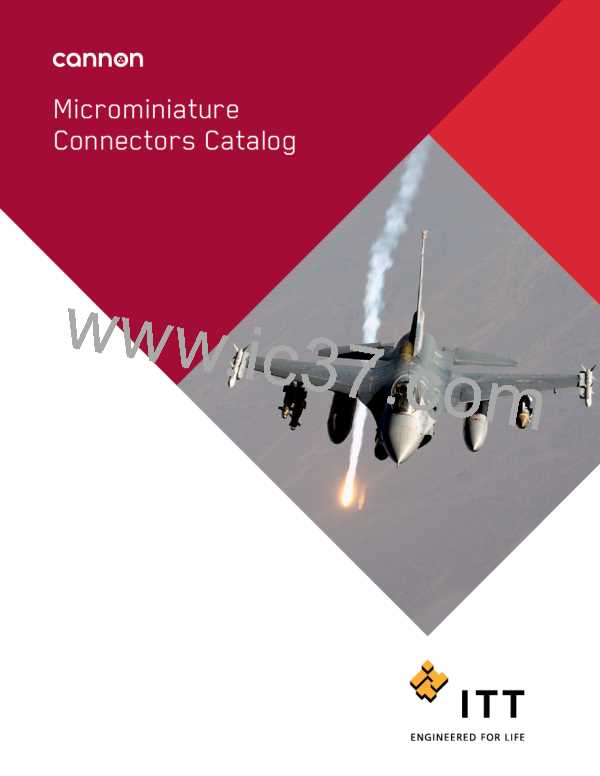Custom Backshells for Microminiature Connectors
ITT Cannon offers a wide range of backshell
solutions for Microminiature Connectors used
in harsh environment applications. Although
we do not offer a standard backshell portfolio,
Cannon engineers can design and manufacture
a range of back fittings for our MDM Series
Microminiature Connectors, depending on
material finishes and sizes and can be provided
with special process termination methods. In
addition, ITT Cannon engineers have developed
a method of riveting the back fitting to the shell
within the jacking area. This option guarantees
360-degree shielding effectiveness even when
jackscrews or jacking posts are not being used.
engineering team can also provide special
back potting style termination systems for
environmental protection and strain relief.
These backshell style systems are typically filled
with epoxy or other encapsulating materials to
provide a robust and effective solution.
customer requirements. We offer custom designs When a conduit system is preferred, such as for
using proven banded systems in which the braid test box environments in field locations, back
is captivated over a chimney-style outlet. These
fittings and a fully screened weatherproof
types of backshell systems are aviable in different convoluted trunking can be used. Our
Sealing Gaskets
We have received requests for gasket materials to seal the MDM connectors into various enclosures. We recommend that you consider wider flanged
connectors together with a low cost conductive gasket to provide an adequate surface area. This combination will give you IP-66 sealing with good EMC
compliance. The following dimensions for gaskets and flange dimensions are regarded as the minimum that you should consider.
Conductive elastomers generally offer a superior shielding performance when compared with alternatives as in table below.
Neoprene (wire
impregnated)
Silicone (wire
impregnated)
Silicone
(oriented wire)
Neoprene
(fabric wrap)
Metallic
finger stock
Conductive
silicone rubber
Gasket Type
Metallic fibres
Shielding performance
Temperature range
IP sealing
S
S
P
G
S
P
S
S
S
G
P
G
G
S
G
S
G
G
P
G
G
P
S
P
P
P
P
G
G
G
S
S
Compression force
Compression range
Surface texture
Compression set
Re-usability
G
S
G
S
G
G
P
G
G
G
G
G
S
P
G
S
S
S
S
G
G
S
S
S
*Neoprene is a trademark of Dupont P = Poor S = Satisfactory G = Good
Conductive rubber gaskets can be loaded with many different metallic fillers but the choice of material is dependent upon a number of factors such as
level of conductivity, shielding effectiveness, galvanic compatibility and cost.
Galvanic Corrosion can occur when two dissimilar metals are in contact with one another in the presence of an electrolyte. The type of gasket material
has to be assessed because of the use of metallic fillers. Many applications are dry indoor environments where corrosion is not a major concern. Howev-
er, for external use, particularly marine, it is recommended that consideration be given to compatibility. The table on the next page is a summary.
Enclosure Material
Aluminum alloys
Magnesium alloys
Stainless steel
Silver/Nickel
Silver/Copper
Silver/aluminum Inert aluminum
Silver/Glass
Silver
X
Nickel/Graphit
Nickel
1
X
X
X
X
1
1
▲
1
X
X
1
1
X
1
▲
▲
X
▲
▲
X
▲
▲
1
▲
▲
1
▲
▲
X
▲
▲
X
▲
▲
1
▲
▲
1
Copper alloys
Cadmium plating
Tin plating
1
X
1
1
1
▲
▲
▲
▲
1
▲
▲
▲
▲
1
Nickel plating
▲
▲
▲
X
1
1
▲
▲
▲
1
▲
▲
▲
X
▲
▲
▲
X
Chromium plating
Silver plating
▲
▲
X
▲
▲
1
Zinc & galvanise plating
Titanium
▲
▲
▲
▲
▲
▲
▲
▲
▲ = good 1= Satisfactory X = Not recommended
Dimensions shown in mm
Specifications and dimensions subject to change
www.ittcannon.com
78

 ITT [ ITT Cannon ]
ITT [ ITT Cannon ]